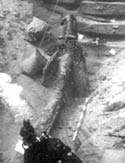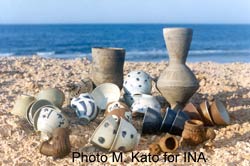|
A 1994 shipwreck survey by the Institute of Nautical
Archaeology - Egypt (INA-Egypt), in cooperation with the Supreme Council of
Antiquities for Egypt (SCA), documented an Ottoman-period 18th century vessel near Safaga
(Haldane, 1994; 1996a).
Qing Dynasty Chinese export porcelain attracted
acquisitive visitors to the site, including a group which dived there more
than 500 times in the early 1990s. Our discovery in 1996 of over 140 stacked
porcelain artifacts buried on the beach suggests that looting was fairly
large scale. Excavation began in 1995 (Haldane, 1996a and 1996b). In
addition to supplying information about a poorly documented period in the
northern Red Sea, the Sadana Island Shipwreck provides a large and diverse
collection of well dated artefacts of the mid-18th century, decades
significant as trade patterns changed to reflect renewed Ottoman interest in
controlling Red Sea commerce.
 Excavation Excavation
The Sadana Island shipwreck lies in 28-40 m of water at the sandy base of
a coral reef about 35 km south of Hurgada, a popular Red Sea diving resort.
The ship sank and settled to one side, parallel to the reef, with its bow
pointed inland. With time, much of the ship broke away and slid downslope
into deep sand and was buried. The stern is particularly well preserved.
Today, many of the ship's internal timbers lie just centimeters beneath the
sand or are exposed. Three, 4-m-long, grapnel anchors mark the bow, and the
ship's frames can be traced continuously along the 50 x 20 m area.
In 1995, the excavation team concentrated on establishing datum points
for mapping the site and clearing its surface of portable artifacts to
prevent further looting losses. After almost 3,000 dives in two excavation
seasons, the ship seems nearly empty. Large storage jars once clustered in
the middle of the site and porcelain, glass and copper objects spread along
the central axis have been removed. The site's major feature is the largest
artefact, the ship itself. Trenches set out along the top (28-30 m deep) and
bottom (32-36 m deep) of the site intersect with three transverse trenches.
In addition to recording timbers in these trenches, team members raised
representative fragments for study and subsequently buried them on site.

porcelain from the Sadana Island wreck
More than 3,000 artifacts are now under conservation in the Alexandria
Laboratory for the Conservation of Submerged Antiquities, a joint project of
the SCA and INA, but we suspect that much of the original cargo was lost to
looting and natural processes of decay in the sea. Recovery of plant and
animal remains is an integral part of our excavation and offers important
evidence for this "invisible" cargo. Today as in the past, pilgrim
traffic is important in Red Sea shipping, however, the paucity of personal
possessions on the Sadana ship (about 30 to date) means that it was not
carrying hundreds of passengers when it sank.
Cheryl
Ward, PhD
Assistant Professor, Nautical Archaeology
Department of Anthropology
Florida State University
Links
|


 Back to Nordic Underwater Archaeology
Back to Nordic Underwater Archaeology